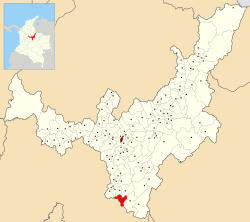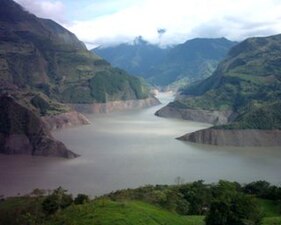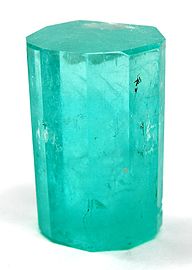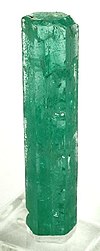Chivor
Chivor | |
|---|---|
Town and municipality | |
 Chivor is world-famous for its emeralds | |
 Flag | |
 Location of the town and municipality of Chivor in Boyacá Department | |
 Chivor Location in Colombia | |
| Coordinates: 4°53′N 73°22′W / 4.883°N 73.367°WCoordinates: 4°53′N 73°22′W / 4.883°N 73.367°W | |
| Country | |
| Department | Boyacá |
| Province | Eastern Boyacá Province |
| Founded | 16 December 1930 |
| Founded by | Florencio Novoa |
| Government | |
| • Type | Municipality |
| • Mayor | Didier Aurelio Martínez Vargas (2020-2023) |
| Area | |
| • Town and municipality | 108.36 km2 (41.84 sq mi) |
| • Urban | 9.9 km2 (3.8 sq mi) |
| Elevation | 1,800 m (5,900 ft) |
| Population (2015) | |
| • Town and municipality | 1,795 |
| • Density | 17/km2 (43/sq mi) |
| • Urban | 486 |
| Website | Official website |
Chivor is a town and municipality in the Eastern Boyacá Province, part of the Colombian department of Boyacá. The mean temperature of the village in the Tenza Valley is 18 °C (64 °F) and Chivor is located at 215 kilometres (134 mi) from the department capital Tunja.[1] Chivor is world-famous for its emeralds.
Borders[]
Bordered to the north with the municipality of Macanal; to the south with Ubalá, Cundinamarca, on the east with the municipality of Santa María, and the west by the municipality of Almeida.[1]
Etymology[]
Chivor comes from Chibcha and means "Our farmfields - our mother" or "Green and rich land". The latter refers to the rich emerald deposits.[2]
History[]
Chivor was inhabited by the Muisca in the times before the Spanish conquest. The Muisca were organized in their loose Muisca Confederation with northern ruler the zaque of Hunza and the southern zipa in Bacatá. Already in those times the rich emerald deposits were known and mined by the Muisca. The emeralds functioned as offer pieces in the Muisca religion, as decoration and as money.
The emerald deposits of Chivor were discovered by Spanish conquistador Gonzalo Jiménez de Quesada in 1537 but the mines were abandoned until 1886.[3]
Modern Chivor was not founded until December 16, 1930 by Florencio Novoa.[1]
Economy[]
Main economical activities of Chivor are agriculture (maize, yuca, bananas, sugarcane, beans, guatilla, coffee and fruits such as papayas, blackberries and the typical Colombian fruits lulo and tree tomatoes) and especially the emerald mining.[1] Only in 2014 emeralds worth 30 million US dollars were extracted in Boyacá. The rich deposits have led to numerous conflicts in the region, including in Chivor.[4]
The Gran Esmeralda de Moctezuma ("Great Emerald of Moctezuma") is a mineral of 21 centimetres (8.3 in) high, 17 centimetres (6.7 in) long and 16 centimetres (6.3 in) thick and has been found in Chivor. Currently the emerald is in Vienna, Austria. Other grand emeralds from Chivor are Patricia weighing 632 carats (126.4 grams (4.46 oz)), and La Magnífica of 1225 carats (245 grams (8.6 oz)).[5]
The Embalse la Esmeralda ("Emerald reservoir") producing hydroelectric energy is governed from Chivor, Macanal and Almeida.
Climate[]
Chivor has a subtropical highland climate (Cfb) with heavy to very heavy rainfall year-round.
| hideClimate data for Chivor | |||||||||||||
|---|---|---|---|---|---|---|---|---|---|---|---|---|---|
| Month | Jan | Feb | Mar | Apr | May | Jun | Jul | Aug | Sep | Oct | Nov | Dec | Year |
| Average high °C (°F) | 24.2 (75.6) |
24.6 (76.3) |
24.4 (75.9) |
24.0 (75.2) |
23.2 (73.8) |
21.8 (71.2) |
21.7 (71.1) |
22.1 (71.8) |
22.7 (72.9) |
23.3 (73.9) |
23.5 (74.3) |
23.6 (74.5) |
23.3 (73.9) |
| Daily mean °C (°F) | 18.3 (64.9) |
19.0 (66.2) |
19.4 (66.9) |
19.3 (66.7) |
18.8 (65.8) |
17.8 (64.0) |
17.6 (63.7) |
17.0 (62.6) |
18.0 (64.4) |
18.4 (65.1) |
18.6 (65.5) |
18.3 (64.9) |
18.4 (65.1) |
| Average low °C (°F) | 12.5 (54.5) |
13.4 (56.1) |
14.5 (58.1) |
14.6 (58.3) |
14.5 (58.1) |
13.9 (57.0) |
13.6 (56.5) |
13.7 (56.7) |
13.4 (56.1) |
13.6 (56.5) |
13.7 (56.7) |
13.1 (55.6) |
13.7 (56.7) |
| Average rainfall mm (inches) | 41.0 (1.61) |
89.2 (3.51) |
137.5 (5.41) |
262.3 (10.33) |
373.5 (14.70) |
401.3 (15.80) |
405.1 (15.95) |
333.8 (13.14) |
242.9 (9.56) |
197.4 (7.77) |
143.2 (5.64) |
67.9 (2.67) |
2,695.1 (106.09) |
| Average rainy days | 9 | 12 | 17 | 24 | 27 | 28 | 28 | 27 | 23 | 23 | 20 | 13 | 251 |
| Source 1: IDEAM[6] | |||||||||||||
| Source 2: Climate-Data.org[7] | |||||||||||||
Gallery[]

Emerald reservoir

Reservoir

Reservoir

Reservoir

Emeralds from Chivor

Emerald

Emerald

Emerald
See also[]
- Muzo, another town in Boyacá famous for its emeralds
- Colombian emerald trade
- Colombian Emeralds
References[]
- ^ Jump up to: a b c d (in Spanish) Official website Chivor
- ^ (in Spanish) Etymology Chivor - Excelsio.net
- ^ (in Spanish) Emerald deposits in Boyacá Archived 2016-03-02 at the Wayback Machine
- ^ (in Spanish) 30 million US dollars of emeralds in 2014 in Boyacá - El Espectador
- ^ (in Spanish) Gran Esmeralda de Moctezuma and other large emeralds from Chivor - Semana
- ^ "Data". www.ideam.gov.co. Retrieved 2020-08-23.
- ^ "Climate: Chivor". Climate-Data.org. Retrieved August 23, 2020.
Further reading[]
- ; ; , and . 1999. Emeralds in the Eastern Cordillera of Colombia: Two tectonic settings for one mineralization. Geology 27. 597–600. Accessed 2017-01-05.
- ; ; ; ; , and . 1995. An evaporitic origin of the parent brines of Colombian emeralds: fluid inclusion and sulphur isotope evidence. European Journal of Mineralogy 7. 151–165. Accessed 2017-01-05.
- . 2007. Tipología y condiciones de formaciónde las manifestaciones del sector esmeraldífero "Peña Coscuez" (municipio San Pablo de Borbur, Boyacá) (MSc.), 1–121. Universidad Industrial de Santander. Accessed 2017-01-05.
- ; ; ; ; ; , and . 2015. Colombian Trapiche Emeralds: Recent Advances in Understanding Their Formation. Gems & Gemology LI. 222–259.
External links[]
- (in Spanish) Hydroelectric energy Chivor
| Wikimedia Commons has media related to Chivor. |
- Municipalities of Boyacá Department
- Populated places established in 1930
- 1930 establishments in Colombia
- Muisca Confederation
- Muysccubun
- Colombian emeralds










